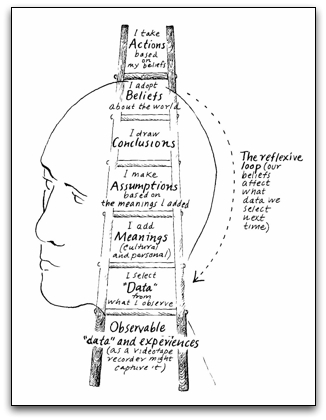The ladder of inference
In Discussing the Undiscussable William Noonan describes the ladder of inference, a tool which can be used to help us achieve double loop learning with respect to our interactions with other people.
Ladder of Inference helps people identify what information or facts are used as the basis for their reasoning process. It also helps people understand how they interpret that information and how they apply their interpretation to the issue or problem at hand. Essentially, the Ladder of Inference is a metaphorical tool designed to help people understand and describe their use of inductive reasoning. Given what we see, what conclusions do we draw?

The book mainly describes the ways that we end up climbing the inference ladder ourselves but I’ve been thinking recently that it’s quite interesting to know that in all likelihood that’s how other people are thinking about the things that we do.
One of the main examples of people climbing the ladder of inference in an 'agile' context is when somebody comes late to the standup in the morning.
The other members of the team often jump up the ladder and come to the conclusion that the late person is lazy/doesn’t care about the project or their time and is generally a bad person, all before finding out why they were late!
The ladder climbing gets even worse if the person is a serial offender and even though it’s unfair to that person, it’s unlikely that you’re going to be able to get all the other people in the team to change their way of thinking.
It therefore makes sense to be aware that people may be making these inferences about our behaviour and perhaps adjust the way we act accordingly.
About the author
I'm currently working on short form content at ClickHouse. I publish short 5 minute videos showing how to solve data problems on YouTube @LearnDataWithMark. I previously worked on graph analytics at Neo4j, where I also co-authored the O'Reilly Graph Algorithms Book with Amy Hodler.
